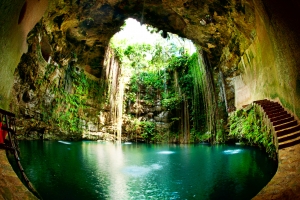
Example of a Cenote Landform:
A cenote is an opening in the ground that occurs naturally with groundwater present. A cenote is often connected to an underground water-filled cave system. Divers sometimes use cenotes as an entry point to explore underwater caverns.
When groundwater dissolves a limestone formation below the ground surface, this can cause the ground to collapse, leaving the groundwater exposed in the pit.
Cenotes can be found where the water table is high and limestone formations are present near the surface. A large number of cenotes exist in the Yucatán Peninsula of Mexico. Very few rivers or streams are present, so that cenotes were the primary source of water available for the native population living there until recently.
A cenote can be less than 30 feet in diameter, while an unusually large one may be hundreds of feet across.
Dos Ojos, Yucatán Peninsula, Mexico
Bottomless Lakes State Park, New Mexico, USA
Ewens Ponds, South Australia
Dos Ojos, meaning “two eyes” in Spanish, is located in the Yucatán Peninsula. Two cenotes connect to a very large undergound cavern between them. They are part of an underwater cave system that includes a total of 28 cenotes found so far. The water is extremely clear which makes it an excellent diving location.
This cave system has been the subject of 2 documentaries and was also filmed for part of a movie, “The Cave” released in 2005. It includes a pit with a depth of 391 feet, and the system is connect to the second largest dry cave system in the world called Sistema Sac Actun in Mexico.
In the Bottomless Lakes State Park of New Mexico there are nine small lakes along the Pecos River that were formed by cenotes. The largest is called Lazy Lagoon, formed from 3 cenotes, and covers 26 acres. Ewens Ponds of South Austtralia is a system of 3 cenotes that are connected below. This is an exceptional diving location with unusually clear water and a garden of underwater plant life, and the rare golden pygmy perch and other fish species.
An opening in the ground where an underground limestone formation has collapsed, exposing groundwater
We want pictures and location of the lanforms around the world and we need your help. Click get started button below.
In Asia, China, India, Nepal, and Bhutan are home to one of the eight wonders of the world and one of the most beautiful mountains in the world, the Himalaya Mountains also called the Himalayas. Boasting as the world’s highest and most famous mountain peak, Mt. Everest. Within the verse of the ‘Kumarsambhava’, Sanskrit […]
Nature have provided us with fascinating landforms and features. The most often adored landforms are volcanoes. Like the perfect cone structure of Mayon Volcano in the Philippines or Mount Fiji in Japan, people look at their beauty and wonder with great appreciation to nature. Volcanoes are mountains with a very disastrous nature. Their only […]
Taal Volcano is the second most active volcano found in the province of Batangas. A complex volcano in the middle of Taal Lake and is often called an island within a lake, that is an island within a lake that is on an island as well as one of the lowest volcano in the […]
Mayon Volcano is one of the active volcanoes in the Philippines. Located in the southern part of Luzon about 473 kilometers (294 miles) from Makati Business District of the Philippines, Mount Mayon is the main landmark of the Province of Albay of Bicol Region. According to local folklore, the volcano was named after Daragang […]
The global temperature and weather is to a large extent a direct result of the sun’s effect to our planet. Together with the atmosphere and the rotation of the earth on its axis. The earth on which weather moves on has its own effect on the weather. The different landforms like mountains, volcanoes, plains, and the […]